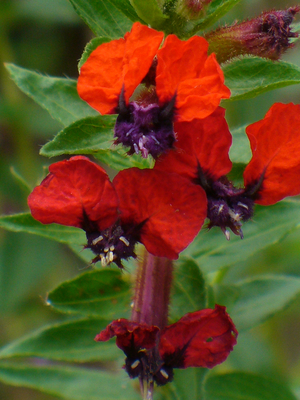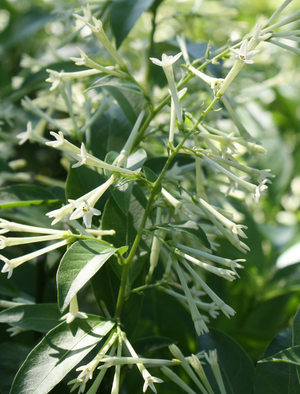Native Plants
Find plants that are native to the USA and are already adapted to your growing area and conditions. Including hardy perennials, trees, shrubs, and vines!
White Texas Star, Lone Star Perennial Hibiscus, White Swamp Hibiscus, Swamp Hibiscus
Hibiscus coccineus 'Lone Star', H. coccineus alba
Giant, snow white 6" pinwheels are produced throughout summer and often well into fall on sturdy stems with finely cut rich green foliage. The White Texas Star or Lone Star Perennial Hibiscus is a pure white form of the Scarlet Swamp Mallow that was selected by Houston plantsman Heidi Sheesley. This is a vigorous sun loving perennial which is native to the swampy soils of the southeastern US but is somewhat drought resistant once well-established in the garden. The glowing white flowers attract a variety of pollinators including hummingbirds, bees, and the occasional butterfly. Caterpillar host: Gray hairstreak. Item# 791.
USDA Cold Hardiness Zones: 6,7,8,9,10 (mulch in 6,7,8)
Grows To: 6-8'H x 5'W
Outdoor Light: Full sun, Mostly sunny, Part shade, Part sun
4.5 inch Pot / 20 fl.oz. / 591 ml
Currently In Stock: 0
US$14.99
Temporarily Out of Stock
Or
Quantity Exceeds Stock Level
Email Me When Ready
Cannot Ship To: OR
US$14.99
Or
Quantity Exceeds Stock Level
Email Me When Ready
Cannot Ship To: OR
White Texas Star, Lone Star Perennial Hibiscus, White Swamp Hibiscus, Swamp Hibiscus
Hibiscus coccineus 'Lone Star', H. coccineus alba
Pot Size: 4.5 inch Pot / 20 fl.oz. / 591 ml
Item# 791
US$14.99
Mini Cart
Your Cart Is Empty
Categories
- 2024 New Plants
- 2024 Sizzlin' Summer Sale
- Agastache
- Angel Trumpets
- Bee Plants
- Bonsai Starter Plants
- Butterfly Plants...
- Camellia & Sasanqua Selector...
- Camellias & Sasanquas
- Cut Flowers
- Deer Resistant Plants
- Epiphyllums
- Figs, Figs, Figs...
- Fragrant Plants
- Fruits & Herbs
- Gardenias
- Gingers
- Great Plant Picks for the Pacific Northwest
- Greg Grant Introductions
- Groundcovers
- Heirloom Plants
- Hibiscus...
- Honeysuckle
- Hoyas
- Hummingbird Plants
- Hydrangeas
- Indoor Plants
- Iris
- Lantanas
- Louisiana Native Plants
- Louisiana Super Plants
- Missouri Botanic Gardens Plants of Merit
- Moon Moth Garden Plants
- Native Plants
- Passionvines
- Perennials - All
- Perennials by Size Class...
- Phlox
- Plants by Flower Color...
- Plants by Foliage Color...
- Plants by Fruit Color...
- Plants for Bogs & Wet Areas
- Porterweeds
- RHS Award of Garden Merit® Plants
- Roses
- Salt Tolerant Plants
- Salvias
- Shade Tolerant Plants
- Shrubs & Trees - All
- Shrubs by Size Class...
- Songbird Plants
- Succulents & Cacti
- Texas Superstar® Plants
- Top Performers from Mt. Cuba Center Trials
- Tropical Plants
- Turks Cap
- Vines and Vine-like Plants
Information
Top Sellers
We Securely Accept
![]()

.jpg)

-1.JPG)
.JPG)


